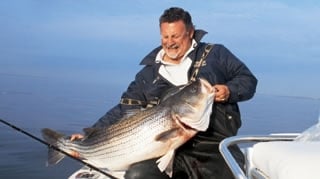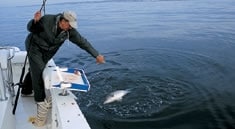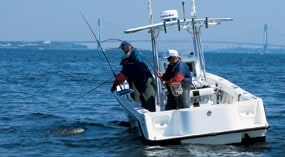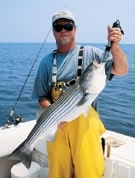
Striper fishermen in New York and New Jersey have had it pretty good lately. Not only does their season extend well into January, it also seems to begin earlier and earlier each year. It used to be that anglers didn’t start targeting striped bass until the first warm breezes of May stirred the air, but that’s changing thanks to a burgeoning catch-and-release fishery in Raritan Bay. The action kicks off in mid-April, and is often best long before the opening of New York’s striper season.
Raritan Bay separates Staten Island from New Jersey’s northern bay shore, and may well be the most productive urban bay in the world when it comes to fishing. Even when water quality was terrible, the bay played host to vast numbers of summer and winter flounder, striped bass, bluefish, weakfish and many other species. Though rarely clear, Raritan’s waters are now of good quality, and there’s no problem with eating any of the fish caught there. The proximity of the Hudson River is probably responsible for producing such a high-quality early-spring fishery, as bass feed up before entering the river in mid-May to spawn. Herring are often abundant early, but it’s menhaden (a.k.a., bunker) that provide the primary spring attraction.

The late Lou Figurelli did an incredible job of improving Staten Island waters and protecting them from commercial fishing. While seiners are able to use spotter planes to ravage schools of bunker on the New Jersey side of the bay, menhaden on the Staten Island side get a pass – except from anglers who catch them with castnets and snagging hooks. The bunker are usually so thick on the Staten Island side that castnetters can usually catch all they need with just a few throws.
How It Started
Credit for developing Raritan’s early-spring fishery goes to Captain Pete Wagner of the Hyper Striper from Highlands, New Jersey, who noticed schools of bunker had arrived in the second week of April 2000 and decided to try trolling bunker spoons, even though the water was only around 45 degrees. He enjoyed immediate success with bass in the teens and 20s before other anglers started catching on. Even if bunker aren’t readily available, the bass seem to be there. Wagner proved this last year when he started clamming for bass on April 14 and wound up catching 11 legal fish (there’s no season on the New Jersey side of the bay) for his charter party, including a 37-pounder.


(top) A fine April bass is worked to boatside from Tony Arcabascio’s Maja out of great Kills, Staten Island. (bottom) Bait up with a bunker and you’ll be luring stripers with their primary spring forage.|
Now we expect to have solid fishing by mid-April, and start looking for bass even earlier if water temperatures aren’t too low. It was March 31 last year when I joined Captain Lou Grazioso and Brian Pieros on the Striper Mania for an Easter-morning experiment in the western end of the bay, where the early action is often best. We launched at Keyport Harbor and trolled the end of the flood tide around hundreds of gannets that were diving on herring near Raritan Reach. However, we only managed to catch two bass of 20 1/2 and 29 1/2 inches on our Mann’s Stretch 25 plugs, which generally work well when herring are the main forage. As the tide started to ebb and the water temperature rose to 48.8 degrees, we made a two-hour attempt at clamming and caught seven more bass, including three 25-inchers. The action wasn’t anything to brag about, but we were delighted to catch stripers of any kind so early in the season. And now we know that schoolies are active very early if water temperatures aren’t too low.
The larger bass seem to arrive with the bunker around the middle of April, and tend to favor the western end of the bay from Raritan Reach right into the Raritan River. Almost all the bass taken on chunks are over 28 inches, with the average fish ranging from the mid-teens to the low 20s – and getting larger every year.

Stripers provide excellent release-only sport prior to the start of New York’s official season. New Jersey anglers can possess bass, in accordance with size and bag limits, year-round.|
“Stupid Fishing”
The numbers aren’t great in mid-April, but within a week or two it’s common to release 20 to 30 large bass, plus some bluefish, per tide. By early May there are so many fish around that the situation is often what local striper pro Tony Arcabascio calls “stupid fishing.” Rather than having to work small, isolated areas, anglers can simply wander around until they mark something on the depthsounder, then throw the anchor and start catching fish on chunks or clams.
When I told Joe Hughes of South Plainfield about the early-season fishery, he was eager to try it, so on May 7 we went out on my Sheri Berri II. We trolled shad umbrella rigs at Raritan Reach on a slack high tide and quickly caught four bass before schools of bunker began surfacing in mid-bay on the ebb. Every cast of a snatch (snagging) hook produced a bunker, which had to be reeled in quickly to prevent big bluefish from taking them. Drifted chunks produced bass up to 25 pounds, although it was necessary to fight five blues for every striper.
By using 7/0 circle hooks on 60-pound fluorocarbon leader, I managed to avoid many cut-offs. Also, no damage was done to any of the bass, since almost all were hooked in the jaw.
Naturally, it wasn’t long before other boats descended on the scene. Surface action usually doesn’t last long when there’s a lot of boat traffic, but the bunker schools refused to sound, and we were constantly hooked up. At one point I was fighting a 15-pound bass when an angler on a nearby boat shouted that I had snagged his line. I let him reel the fish in, whereupon he discovered that it had both of our hooks in its mouth!
| ### Early-Spring## Striper ChartersThere’s a large fleet of charter boats along the northern Bay Shore of New Jersey at such ports as Highlands, Atlantic Highlands, Leonardo and Morgan, as well as a couple out of Great Kills Harbor on Staten Island. Phone numbers for those boats noted in the article, all out of Highlands, are:Sheri Berri II (Capt. Al Ristori) (732) 223-5729Striper Mania (Capt. Lou Grazioso) (732) 739-2397Hook Em Up (Capt. Pete Kwolek) (732) 687-0518******Tackle Box Sportfishing (Capt. Philip Sciortino) (732) 264-7711******Hyper Striper** (Capt. Pete Wagner) (732) 212-1847****Party boats begin evening trips from Atlantic Highlands, Leonardo, Keyport and Perth Amboy when bass fishing gets solid around the beginning of May. Captain Jerry Ciriello is the first to start nightly striper trips with the Freddy-C, (732) 291-9303, from Leonardo and continues right through late fall. Some party boats may also run daytime striper trips in the spring.** |
Hughes and I left the scene when Captain Phillip Sciortino of Tackle Box Sportfishing radioed that he was catching mostly bass while chunking at anchor near the Reach. We finished the trip there with some more bass, then ran back to Highlands. On the way we encountered school after school of bunker, and couldn’t resist making a stop, which resulted in another bass and more blues. In just one morning of red-hot fishing we had released 21 stripers and at least 80 blues – leading all hands to agree that this was indeed “stupid fishing!” It’s not like that every day, of course, and the wild action usually settles down to the point where the pros have to anchor on their secret spots in order to score consistently.
Lots of Big Fish
Raritan Bay’s early-season stripers can be taken in a variety of ways. There are days when surface plugging works well, though that’s usually the exception. Fly-rodders don’t enjoy as much surface action as in the fall, but are still able to score with big fish on sinking lines by drifting over marks on the depthsounder. (Richie Fink boated a 36 3/8-pound IGFA fly-rod world record on 20-pound tippet last April 24.) Wire-line trolling with shad umbrella rigs and bunker spoons can produce consistent action, and trolled plugs also work well most of the time. However, nothing beats a real bunker!
Bunker not only produce lots of bass, but some of the largest fish. Arcabascio, one of Staten Island’s most respected striper captains, caught fish up to 42 pounds last spring on bunker, though all of his biggest fish were hooked before the May 8 season opener. He managed a 32.55-pounder during the mid-May American Striper Association Sandy Hook Tournament, but was nipped for first place by a 32.77-pound fish.
| ### Watch the## Limits! | ||
| It’s important to pay attention to the boundary between New York and New Jersey waters in Raritan Bay, as the two states have different seasons and limits. * New York’s season, unless changed this spring, runs from May 8 to December 15, with a limit of one bass of 28 inches or more. Party and charter boats with New York permits are allowed two fish measuring 28 inches or more per customer. ¿ * New Jersey anglers can fish all year with a limit of one striper at 28 inches or more, plus a slot-size fish of between 24 and 28 inches. In addition, there’s a bonus-card program that allows anglers to keep a second 28-inch-plus bass.Keep in mind that the limits apply to the state in which the boater is fishing at the time, not where the fish are caught. Thus, a New Jersey boater in possession of a slot-size bass, or two bass, will be committing a violation if he crosses into New York waters, even if his fish were hooked in New Jersey waters. The line between states is clearly shown in Capt. Vic Galgano’s Raritan Bay fishing chart, available at tackle shops or directly from Capt. Vic’s Enterprises, (732) 821-8810. The boundary runs through Raritan Reach, just west of Buoy 14, with the Reach being entirely within New York waters west of there.- Al Ristori |
Live bunker often provide exciting sport, and that was especially the case before the 2002 Memorial Day weekend, when a run of large bass developed near West Bank Light. Those fish gobbled menhaden like candy! Though live bunkers are best fished on treble hooks, I experimented with 7/0 and 9/0 circle hooks and had no trouble hooking up.
Clams Come On
Bunker-chunking action usually levels out toward the end of May, when it becomes more of a night fishery, while clamming begins to dominate the daytime action. Whereas the early run is made up almost entirely of large bass, with few New Jersey slot-size fish (24 to less than 28 inches) thrown in, the slots dominate from late May into early July, or until the run peters out. Even so, bass in the teens remain common, and a few in the 20s are also caught.
Clamming action is often wild, making the use of circle hooks more important. That’s because clams are usually sucked down in a flash, causing a high level of mortality when J-hooks and even offset circle hooks are used. Night clamming tends to be more effective as the waters warm, especially during periods of heavy boat traffic. It’s usually important to have fresh clams, and to chum consistently. Grazioso puts over two chum pots full of clam bellies and also cracks surf clams to spread around the boat. At times, it’s also effective to squeeze some clam bellies and drop them astern, especially when the current isn’t screaming.
For better or worse, big bluefish are part of Raritan Bay’s spring striper fishery. They usually arrive at the beginning of May, but last year we started catching them on April 20. Most are very long and skinny, weighing much less than they do in the fall after a summer of feeding inshore. Needless to say, bluefish love bunker, so anglers have no choice but to deal with them.Arcabascio prevents cut-offs by rigging with black, nylon-covered, steel leader, and still catches plenty of bass. I prefer to rig with heavy fluorocarbon leader and circle hooks. The latter prevents cut-offs by catching in the corner of the fish’s jaw most of the time.
If lots of action with large bass in shallow and fairly protected waters sounds like a good deal, don’t pass up an opportunity to get in on the great spring run in Raritan Bay. While other anglers are still dreaming about bass, you can be catching them! Just be sure to stick with circle hooks and release those big spawning-age fish so we’ll be able to enjoy great action far into the future.









